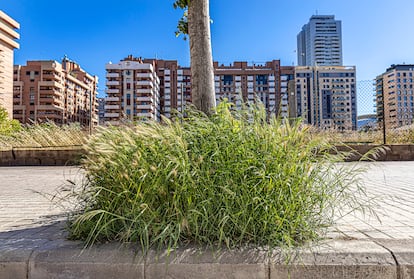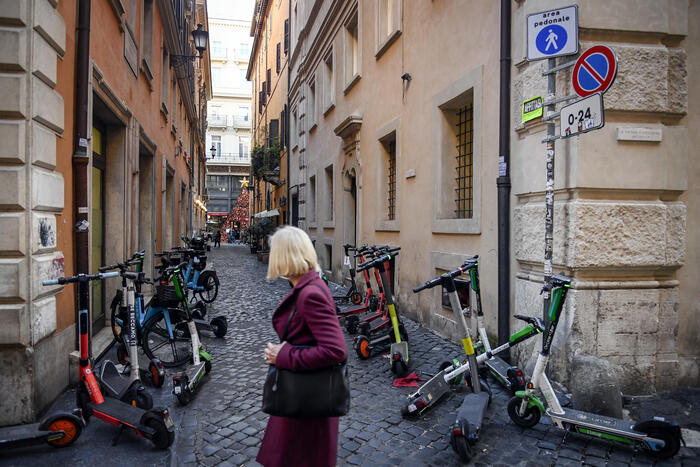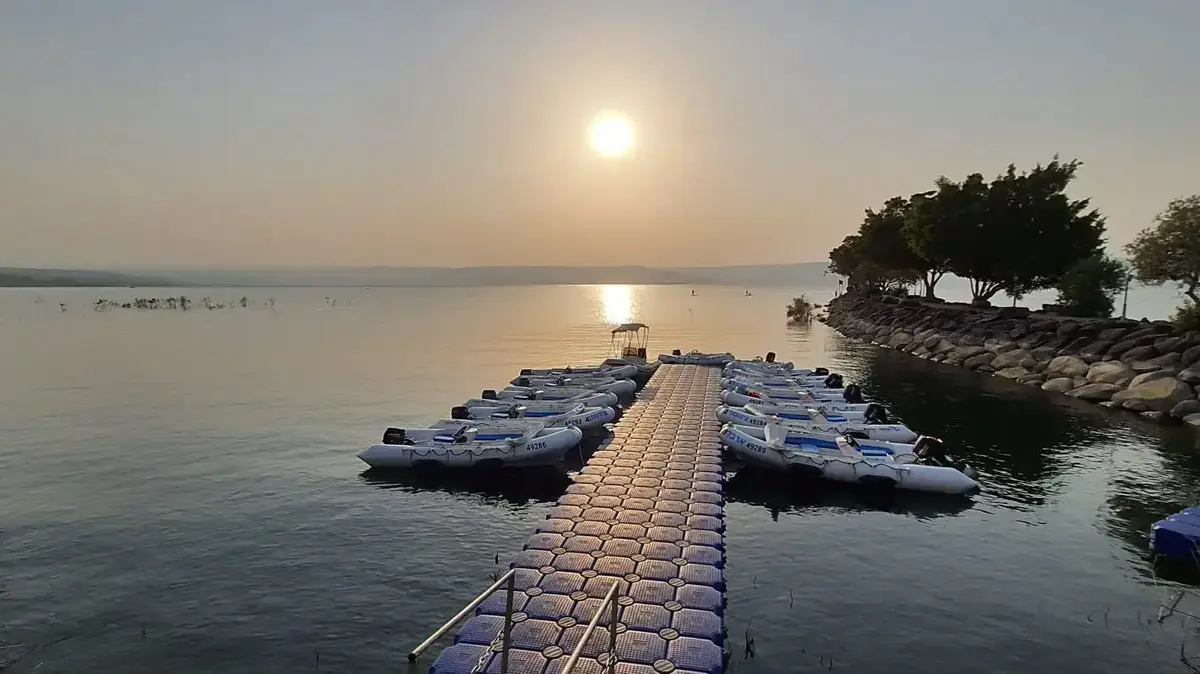The pandemic has been for many the greatest demonstration that cities need to be feral.
When suddenly the world shrinks and life is reduced to a neighborhood, a street or what happens on the other side of a window, the need for nature in these ecosystems of cement and asphalt becomes more evident.
In recent years, the concept of renaturation has made its way into cities.
Among the best known are projects such as the Manzanares river in Madrid or the green belt in Vitoria, but without leaving Spain there are many other examples of this green recolonization of the urban landscape.
Barcelona's parks, wilder than ever
In the harshest months of the covid in 2020, when all of Spain was confined, in the closed parks of the cities the vegetation grew as it pleased and invaded spaces left by humans in the wild. In Barcelona, the gardeners who re-entered these green areas three months later found nature unbridled, more teeming with life than ever, but they did not try to tame it again. On the contrary, the City Council took advantage of this unforeseen situation to complete the radical change in the management of urban parks and gardens in which it had been working for some time. "The confinement accelerated everything," says Coloma Rull, a technician from the Barcelona green area, who assures that some indicators of biodiversity soared, such as that of the butterflies in Montjuïc."The confinement accelerated the naturalization of many sites, a process that otherwise would have been done more gradually," he notes.
This change is taking place in other cities as well. It is one of the strategies to bring nature closer to people in urban spaces: to encourage ecological processes to continue in parks and gardens. “What are considered weeds, for us they are not. We prefer to call them spontaneous herbs ", says Rull, who assures that this recolonization of nature in the urban environment" is like a great experiment, we are all experimenting ". The result is green areas in which the previously common grass is replaced by meadows, those spontaneous herbs, more native species and, above all, much more rich flora and pollinating insects. This metamorphosis can already be seen in parks such as Pla i Armengol or Diagonal Mar. But not in all green areas,since it is more difficult to apply in crowded spaces. "There are those who value it very much and those who see it as sloppiness," says Rull, who makes it clear about the latter: "Renaturation means maintaining in a different way, not abandoning."
The Batán stream has been introduced in the comprehensive reform of Avenida de Gasteiz, in Vitoria.
Rich / EPS
Water instead of asphalt in Vitoria
The old Avenida de Gasteiz de Vitoria was designed with urban planning criteria from the seventies of the last century and had five lanes for the circulation of cars, five lanes for parking and, in the middle, a pedestrian walkway. In 2015, a comprehensive reform was completed that made 400 parking spaces disappear, reduced car traffic and improved space for bikes, trees and pedestrians. But it was also used to introduce a stream, the Batán, which now flows through the middle of the avenue, where there used to be asphalt. “With the expansion of the city many streams were buried; clean water that was mixing with dirty water in the sanitation network, here it was dug up and recovered ”, comments Ane Itziar Velasco, from the Center for Environmental Studies in Vitoria.Apart from the aesthetic value and other environmental benefits, this intervention with water also sought to bring more biodiversity into the city.
The capital of Alava began to work on renaturation several decades ago, when this word was not yet used. Among its most iconic projects are also the green belt that surrounds the city or the Salburua Park, a wetland recovered in 1994 to regulate avenues that today is considered a Ramsar site, that is, of international importance. Among the species that can be seen there are the European mink, the tufted pochard, the browed warbler, the agile frog ... “When they gave us a kilometer to expand in the first exits after confinement, in Vitoria everyone had access to spaces green spaces or even natural spaces ”, Velasco highlights. However, this specialist believes that there is still much to do. "These are nice projects,but it is no longer just about biodiversity to improve the well-being or health of the population, now there has been more evolution to ecosystem services ”, he emphasizes. "This must be something structural."
An image of Valencia.
Tree pits with vegetation to favor the pollination of bees on the outskirts of Avenida de Baleares.Mònica Torres / EPS
Nature in a square meter in Valencia
Although the challenge is to think more and more about the whole of a city or even a region, biodiversity is measured on another scale: small advances of nature can have a very big impact in the middle of cement. In Valencia, one of the greatest transformations of the urban landscape has occurred in areas of just one square meter. These are the most common dimensions of tree pits, those open spaces on the sidewalks where trees grow. In many cities, these tree pits are as deserted as the lunar surface, since it is very common to use herbicides to prevent herbs from growing spontaneously. However, in Valencia, adventitious plants (weeds) are allowed to recolonize them freely, filling with flowers in spring.
Today they have 65,000 tree pits and each one of them can make a difference on a street, according to Sergi Campillo, vice mayor and councilor for Urban Ecology of this city: “What people in the neighborhood have are their trees, it's their nature, its reservoir of biodiversity ”. Although there are always voices against that still see this plant explosion as a sign of neglect, the reality is that this policy change at the foot of the tree has meant the hiring of 20 more people to control the growth of the plants and take care of the irrigation in the Valencian capital. "We must change the vision of cities, as they can also be a space of opportunity for biodiversity," says Campillo, who assures that these tree pits not only now come out bright colors and aromas,but also pollinators and other very interesting insects for cities.
Urban gardens on the banks of the river Tormes in Salamanca.
David Arranz / EPS
A butterfly micro-reserve in Logroño
The harlequin butterfly (Zerynthia rumina) is one of the most beautiful lepidopterans that can be seen in Spain. In fact, it is not possible to do so on many other sites. This species with yellow, red and black wings lives mainly in the Iberian Peninsula and southern France. One of those privileged places is in Logroño. Just take bus line 3 and go to the El Campillo neighborhood, on the edge of the city, right where the asphalt streets and lawns end. Here, in an arid area of typical Mediterranean scrub of a few hectares, the Zerynthia association tries to create the first micro-reserve of butterflies in an urban environment in Spain. In the cases of plants or insects that do not move much, it is not necessary to protect very large areas to achieve results.
This Spanish association for the protection of butterflies has already managed to establish other micro-reserves in rural areas of Navarra, Huesca, Soria, Ávila or Valencia with which it tries to safeguard small valuable areas for threatened species or of singular importance. The difference in this case, as Yeray Monasterio, president of Zerynthia, explains, is that the expansion of the city has turned this enclave into an island of biodiversity in an urban environment. According to the entomologist, the problem now is that “if the city continues to grow and this space ends up covered with grass, the harlequin butterfly would disappear from all over Logroño”. Although this is a rather exceptional example, the so-called butterfly oases are more common in cities:another figure promoted by this association in collaboration with citizens to create small spaces with native plants in schools and city neighborhoods that favor the presence of these lepidopterans. As Monastery affects, it is another way of making cities more permeable to biodiversity.
On the banks of the river Tormes, in Salamanca, there are more than 600 urban gardens.
In addition to providing food to the neighbors, they contribute to the recolonization of plants and to bring biodiversity closer together.David Arranz / EPS
Orchards on the banks of the Tormes in Salamanca
Less than two kilometers from the center of Salamanca, the first citizens selected by public lottery have already begun to work in the urban gardens placed on the banks of the River Tormes, in a new park created after the recovery of a degraded area of 100,000 square meters. The opening of these 617 orchards constitutes one of the actions carried out within a much broader strategy for the green regeneration of this city: apart from providing food, planting tomatoes and lettuce also contributes to the re-colonization of plants and closer to biodiversity. As José Antonio de la Fuente, director of the Environment area of the Salamanca City Council, comments, “they are not orchards designed both for production and to generate life”, which nature brings and that of the neighbors,because plants also work to bring people closer. —Eps







